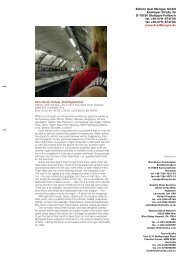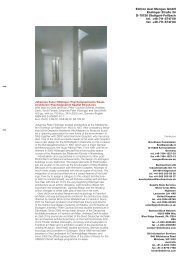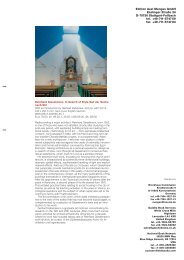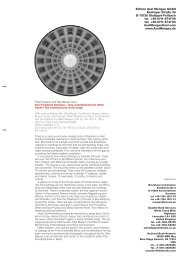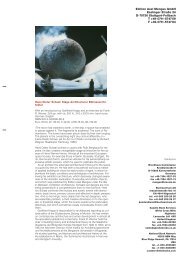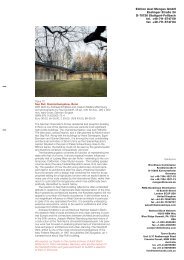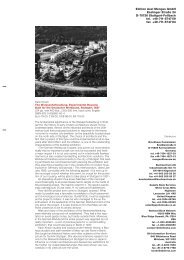Learning from Hollywood - Edition Axel Menges
Learning from Hollywood - Edition Axel Menges
Learning from Hollywood - Edition Axel Menges
Erfolgreiche ePaper selbst erstellen
Machen Sie aus Ihren PDF Publikationen ein blätterbares Flipbook mit unserer einzigartigen Google optimierten e-Paper Software.
Spiritual spaces<br />
Film architecture – interiors and exteriors – is always architecture that has been depicted, photographed,<br />
turned into an image. It embraces the actors and scenes like an air-space that has<br />
become visible, like a built coat, a petrified robe, a stage set. Its presence defines the setting,<br />
the social position of the characters and their inner mood. The openings in the walls and ceilings,<br />
the windows, doors and slits, determine the geometry of incident light. Visible light<br />
sources complete the picture. Film architecture is fictional architecture. It is unimportant<br />
whether a city, a building, a room exist in reality or whether only the façades have been built<br />
up. Film architecture is an architecture of meaning. 2 There is nothing in the frame that is not<br />
important and does not have something to say. Of course this architecture is constructed and<br />
its importance appreciated only for the short moment of being filmed, after that it is in the way,<br />
and rots away as a tiresome ruin or is taken down, unless it becomes part of a studio tour. It<br />
lives its true life in the film, as a new, atmospheric truth. Camera and film have transformed it<br />
<strong>from</strong> studio reality into media fiction. Film architecture works in statements and images, with<br />
built psychology, spiritual spaces, spiritual landscapes. Film space is an emotional place made<br />
up of walls, light and shade. The more intense, brilliant and melancholic the atmosphere becomes,<br />
the more powerful is its effect in the film. This unity of mood between character and<br />
place has been sought <strong>from</strong> the very beginning. German Expressionist films were the great pioneers<br />
here – even if on a somewhat exaggerated plane – and made world-wide impact with<br />
their work. The heroes of these films, threatened <strong>from</strong> inside and out, often mad, and communicating<br />
by means of supernatural powers, roam with the exalted gestures of silent film<br />
through a labyrinth of narrow alleys that can represent both a medieval city and a spiritual<br />
space that has become visible.<br />
City, house, room, chamber, street, alley – every motif is demonized and related directly to<br />
the characters involved as a psychological element. These characters were seized by panic<br />
fear as buildings crashed down on them, and saw personal deaths on steps and in alleyways.<br />
The built labyrinth wrapped itself round their necks and killed them. What Expressionist pictures<br />
had formulated before them (Ludwig Meidner and Ernst Ludwig Kirchner) was realized<br />
as a moving film image in The Cabinet of Dr. Caligari (1919/20). The effect of an oil painting<br />
hanging in a museum was far exceeded here in the cinema’s black box. People saw their own<br />
nightmares in the projected image at the end of the tunnel, unreality breaking into the waking<br />
consciousness in a way that was almost real. The film – and thus its architecture – had arrived<br />
at the core of its own effectiveness: a day-dream become image, day-dream space become<br />
image, with all the magic of an archetypal spell, a sober intoxication, a fictitious journey<br />
through world, city, life and ego. And also a journey through time and space with picture-stories<br />
of childhood, feelings, despair, love and hate, adventure, danger and death. An easy<br />
death in the cinema gives the viewer in the darkened cinema the divine feeling of being immortal,<br />
able to step out into the night as a survivor.<br />
All subsequent film spaces and film architecture developed <strong>from</strong> the Expressionist spacecell<br />
with its atmosphere of actors, mood of the times, social status, level of consciousness,<br />
of face, body, architecture and light fused into pictorial unity. There are elements of this insideoutside<br />
inversion in French films by Marcel Carné and René Clair, in the <strong>Hollywood</strong> Black Series<br />
and the films of Alfred Hitchcock, in Billy Wilder and in early films by Luchino Visconti and<br />
Federico Fellini, in Ingmar Bergman’s and Woody Allen’s films. Every great film director tried<br />
to create this unity. And this often means that the chosen space, the building or the city becomes<br />
the leading character in the film: The Cabinet of Dr. Caligari, Metropolis, Key Largo,<br />
Sunset Boulevard, The Silence, Viridiana, Manhattan, Roma, Subway, Batman, Psycho,<br />
Shadow of a Doubt, Rear Window, Notorious, Rebecca, The Blue Angel, The Last Laugh,<br />
King Kong, Blade Runner, Pulp Fiction.<br />
Films set in front of an empty white wall, in non-places, are scarcely conceivable. Space<br />
and architecture have always to be firmly established within the landscape, the city and the<br />
real or fictitious society. Where the story is set is crucial: on a skyscraper, in a house in a village,<br />
a castle, a palace, an ordinary home, at the bottom of the sea or in outer space, detached<br />
<strong>from</strong> everything.<br />
16<br />
Seelenräume<br />
Die Architektur des Films – die Innen- und die Außenräume – ist immer eine abgebildete, abphotographierte,<br />
zum Bild gewordene Architektur. Sie umgreift die handelnden Schauspieler<br />
und die Szenen wie ein sichtbar gewordener Luftraum, wie ein gebauter Mantel, ein versteinertes<br />
Kleid, ein Bühnenbild. Sie bestimmt den Ort der Handlung, die gesellschaftliche Stellung<br />
der Personen und deren innere Stimmung. Die Öffnungen der Wände und Decken, die<br />
Fenster, Türen und Schlitze, legen die Geometrie der Lichteinfälle fest. Sichtbare Lichtquellen<br />
ergänzen das Bild. Die Architektur des Films ist eine Architektur der Fiktion. Es ist unwichtig,<br />
ob eine Stadt, ein Haus, ein Raum real existieren oder ob nur die Fassaden aufgebaut worden<br />
sind. Filmarchitektur ist Bedeutungsarchitektur. 2 Innerhalb des Bildausschnitts gibt es nichts,<br />
was nicht wichtig wäre und mitspräche. Allerdings wird diese Architektur nur für den kurzen<br />
Moment des Abgefilmtwerdens aufgebaut und in ihrer Bedeutung gewürdigt, danach steht sie<br />
im Weg, zerfällt als lästige Ruine, oder man reißt sie ab, es sei denn, sie wird zur Station einer<br />
Studiotour. Im Film lebt sie als neue, stimmungsvolle Wahrheit ihr wahres Leben. Sie ist mit Kamera<br />
und Film aus der Studiorealität in eine mediale Fiktion verwandelt worden. Filmarchitekturen<br />
sind Aussage- und Bildarchitekturen, gebaute Psychologien, Seelenräume, Seelenlandschaften.<br />
Der Filmraum ist ein emotionaler Ort aus Wänden, aus Licht und Schatten. Je<br />
intensiver, glänzender und melancholischer die Raumatmosphäre, desto stärker die Bildwirkung<br />
im Film. Von Anfang an wurde diese Einheit von Stimmung der Person und Stimmung<br />
des Ortes angestrebt. Es war vor allem der deutsche expressionistische Film, der hier – wenn<br />
auch übertriebene – Pioniertaten vollbrachte und damit eine weltweite Wirkung erzielte. Die innen<br />
und außen bedrohten, oft geisteskranken, mit übernatürlichen Kräften kommunizierenden<br />
Helden irren mit exaltierter Stummfilmgestik durch ein Gassenlabyrinth, das sowohl eine mittelalterliche<br />
Stadt als auch einen sichtbar gewordenen Seelenraum darstellen kann.<br />
Stadt, Haus, Zimmer, Kammer, Straße, Gasse – jedes Motiv wurde dämonisiert und als psychologisches<br />
Moment direkt auf die handelnden Personen bezogen. In panischer Angst sahen<br />
diese die Fassaden auf sich niederstürzen, erblickten in Treppen und Gängen persönliche Todesfallen.<br />
Das gebaute Labyrinth schnürte sich um ihren Hals und brachte sie um. Was in<br />
den expressionistischen Bildern vorformuliert worden war (Ludwig Meidner und Ernst Ludwig<br />
Kirchner), wurde zum Beispiel im Cabinet des Dr. Caligari (1919/20) im bewegten Filmbild realisiert.<br />
Die Wirkung eines im Museum aufgehängten Ölbilds wurde hier in der schwarzen Kiste<br />
des Kinos weit übertroffen. Man sah am Ende des Tunnels im projizierten Lichtbild den eigenen<br />
Angsttraum, das fast reale Hereinbrechen des Unwirklichen in das hellwache Bewußtsein. Der<br />
Film – und damit seine Architekturen – war im Kernbereich seiner eigentlichen Wirkung angekommen:<br />
bildgewordener Tagtraum, bildgewordener Tagtraumraum mit der Magie eines archetypischen<br />
Zaubers, eines nüchternen Rauschs, einer fiktiven Reise durch Welt, Stadt, Leben<br />
und Ich. Auch eine Reise durch Raum und Zeit mit Bildergeschichten von Kindheiten, Gefühlen,<br />
Verzweiflungen, von Liebe und Haß, von Abenteuer, Gefahren und Tod. Das leichte Sterben im<br />
Kino vermittelt dem Zuschauer im dunklen Kinosaal das göttliche Gefühl, unsterblich zu sein<br />
und als Überlebender hinaustreten zu können auf die nächtliche Straße.<br />
Aus der expressionistischen Raumzelle mit ihrer zur Bildeinheit verschmolzenen Atmosphäre<br />
aus Schauspieler, Zeitstimmung, Gesellschaftsstand, Bewußtseinsgrad, aus Gesicht,<br />
Körper, Architektur und Licht entwickelten sich alle folgenden Filmräume und Filmarchitekturen.<br />
Man findet Elemente dieser Innen-Außen-Verkehrung in den französischen Filmen von<br />
Marcel Carné und René Clair genauso wie in der Schwarzen Serie <strong>Hollywood</strong>s und in den Filmen<br />
Alfred Hitchcocks, bei Billy Wilder ebenso wie in den frühen Filmen von Luchino Visconti<br />
und Federico Fellini, in den Filmen Ingmar Bergmans und Woody Allens. Jeder große Filmregisseur<br />
versuchte, diese Einheit herzustellen. Dabei kommt es immer wieder vor, daß der gewählte<br />
Raum, das Haus oder die Stadt zur Hauptperson des Films wird: Das Cabinet des Dr.<br />
Caligari, Metropolis, Hafen des Lasters/Gangster vor Key Largo, Boulevard der Dämmerung,<br />
Das Schweigen, Viridiana, Manhattan, Fellinis Roma, Subway, Batman, Psycho, Im Schatten<br />
des Zweifels, Das Fenster zum Hof, Weißes Gift/Berüchtigt, Rebekka, Der blaue Engel, Der<br />
letzte Mann, King-Kong und die weiße Frau, Blade Runner, Pulp Fiction.<br />
Filme vor leerer, weißer Wand, an Nicht-Orten sind kaum vorstellbar. Raum und Architektur<br />
müssen fest in die Landschaft, die Stadt und die reale oder fiktive Gesellschaft eingebaut sein.<br />
Entscheidend ist, wo die Geschichte spielt: auf einem Wolkenkratzer, in einem Dorfhaus, in<br />
einer Burg, einem Schloß, einer Bürgerwohnung, am Grund des Meeres oder losgelöst von allem<br />
im Weltall.<br />
17




